Show Caves Top 10
There are so many sites on the internet, the top 10, the top 5, the greatest in the world and much more. We have some lists in this section, the longest caves, the deepest, the oldest show caves, the first with electric light and so on. All these criteria are objective, length can be measured and which is the longest does not depend on the opinion of an individual. In this case, however, we have decided to make a list that reflects an opinion. A list of the greatest show caves in the world is a bit like a list of the 100 books you must read before you die. And it depends to a large extent on the personal opinion of the person making it.
- Firstly, it has to be a real show cave, no climbing or even swimming.
- There is light, a guide and official opening hours
- You don’t have to be a group to book a guided tour, any tourist can visit this cave without any problems.
- It has to be a cave, not a gorge or ravine, and not a cenote.
- It must be in a country that tourists can travel to, i.e. not a weird African state ruled by a military junta, not a U.S.A. with a Trump government and not a country at war.
- And finally, otherwise this wouldn’t be a "top" list: the cave really has to be outstanding!
The following list is not a ranking, the order is arbitrary. The only classification is that we have colour-coded caves in countries for which there is a travel warning. Unfortunately, given the current political situation, we strongly advise against visiting them.
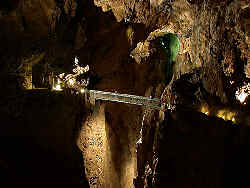
|
 Skocjanske Jame Skocjanske Jame
Slovenia |
The Cave of St. Kanzian is spectacular, an underground gorge, a huge double doline with vertical walls, a natural bridge large enough for a village to be built on it. The huge underground gorge was opened up by building a path and soon after exploration, visitors were able to enter it. However, it took several decades before the cave was developed into a real show cave. And the development continues, the paths are constantly being improved and maintained, the bridge was renewed a few years ago and the cave was finally added to the UNESCO World Heritage List in November 1986. They are very proud of the fact that it is the only cave in Slovenia on the WHL list. |

|
 Eisriesenwelt EisriesenweltÖsterreich |
Eisriesenwelt is the largest ice cave in the world. The halls are decorated with all kinds of ice formations, gigantic pillars and towers of ice, ice waterfalls and glaciers. There are huge chambers that are completely free of speleothems, with several metres of ice on the floor, corridors that are almost completely filled with ice and corridors that are completely filled with ice. Sometimes it is necessary to cut a tunnel through the ice to get there. In certain places, the ice melts and freezes again, forming icicles. And it is probably the show cave with the best view. It takes more or less a whole day, from the car park near Werfen, with the shuttle bus to the ticket office, 15 minutes walk to the cable car, cable car ride, from the Dr. Oedl Haus up to the cave. And back again after the 2-hour guided tour. |

|
 Grotta Gigante Grotta GiganteItalien |
Grotta Gigante is a truly enormous cave hall, 280 m long, 65 m wide and 107 m high. For a long time, it was the largest show cave hall in the world. However, if you interpret La Verna in France as a show cave, it is the new number one. There are several other passages, but these are not part of the tour. The cave is part of the system of the underground river Timavo, which enters the Karst at San Kanzian. |

|
 Peştera Urşilor Peştera UrşilorRomania |
Peştera Urşilor means "bear’s cave".
The cave was given this name because numerous
 Höhlenbären (Ursus spelaeus)
were found in this cave.
The cave was regularly visited by these large animals until around 15,000 years ago.
At that time, a rockslide closed the entrance.
There is a horror story that more than 140 bears were still in the cave.
The bears became hungry and killed each other until they were all dead.
This story is told through their remains, bear bones with the marks of bear teeth, of 140 individuals, which cover the floor of large parts of the cave.
Most of the bones, however, were deposited tens of thousands of years earlier. Höhlenbären (Ursus spelaeus)
were found in this cave.
The cave was regularly visited by these large animals until around 15,000 years ago.
At that time, a rockslide closed the entrance.
There is a horror story that more than 140 bears were still in the cave.
The bears became hungry and killed each other until they were all dead.
This story is told through their remains, bear bones with the marks of bear teeth, of 140 individuals, which cover the floor of large parts of the cave.
Most of the bones, however, were deposited tens of thousands of years earlier.
|
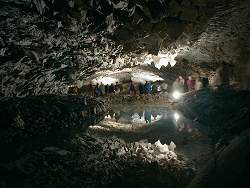
|
 Barbarossahöhle BarbarossahöhleDeutschland |
Gypsum caves are rare and exotic, which makes it all the more interesting to visit one. This is only possible in a few places in the world, but Germany has several. The cave has several large lakes, which have a special green colour due to the extraordinarily high gypsum content of the water. This is due to the special filtering of the incoming light by the dissolved gypsum. The water appears completely clear and clean and, according to measurements, has exceptionally little turbidity. The green colouring only becomes visible at greater water depths. |
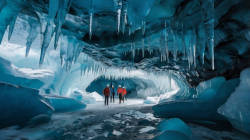
|
 Natur Eis Palast Hintertuxer Gletscher Natur Eis Palast Hintertuxer GletscherAustria |
Glacier caves are natural caves in a glacier, they are rare, usually located in remote areas and are also dangerous. This is one of the most spectacular, and it is located in the middle of Europe, is easily accessible by cable car and also has very unusual ice formations. I consider this to be an absolutely exceptional cave and a unique experience. However, I must also mention that the high entrance fee and the cable car ride make this a rather expensive experience. Nevertheless, I am convinced that the cave is worth every cent! |

|
 Waitomo Caves Discovery Centre Waitomo Caves Discovery CentreNeuseeland |
The Waitomo region has about half a dozen show caves, each of which is extraordinary.
The most famous is, of course, the one with the glow worms, officially known as Arachnocampa luminosa, which are only found in New Zealand and Australia.
Millions of these small insect larvae live in the caves of Waitomo and emit a distinctive light from their bodies.
Unfortunately, images of this are protected by copyright, so here is only a picture of the cave entrance after heavy rain.
We decided to include the Waitomo Caves Discovery Centre in the list because it is the heart of Waitomo and also a kind of visitor information centre. It is the ideal introduction to the Waitomo Caves area. Many of the activities in the area begin and end at the museum, and all forms of transport stop here. The Visitor Information Centre offers everything you need to know about the Waitomo region and takes bookings for Black Water Rafting, Lost World Adventures and many other activities in the area. In other words, this town with the amount of cave tours on offer is worthy of inclusion on this list. Incidentally, the glow worm can be found in every cave in the region. |

|
 Jenolan Caves Jenolan CavesAustralien |
The Jenolan Caves are located in the south-west of the Blue Mountains in the Central Tablelands region.
They are located in a 2,416-hectare protected area for plants and animals called the Jenolan Karst Conservation Reserve.
There are many caves in New South Wales, but these are the most famous and most visited show caves in Australia.
According to Cigna/Burri [2000], they have 240,000 visitors a year.
This is despite the fact that you have to drive for hours through the bush to get there.
It seems to be typical of Australia that cave systems are developed in such a way that they have several show caves. Jenolan is the mother of all these show cave agglomerations, as numerous passages have been developed as show caves over its almost 200-year history. However, as this is an ongoing process, the number of show caves changes from time to time. When we first created this page in the 1990s, there were nine caves that were open to the public. At the moment, six are guided, four are self-guided, and three are closed. |

|
 Postojnske Jame Postojnske JameSlowenia |
At first I wasn’t sure whether I should include the Postojnska Jama in this list? It’s a tourist trap and probably the most visited show cave in the world with 1 million visitors a year. That’s probably more of a turn-off. But the cave is actually great, and not primarily because it has amazing stalactites. It has a train that takes you 3 kilometres through the cave and back again after the tour, it has an underground ballroom with crystal chandeliers, it has a historic entrance building. There is also a museum with cave animals, which is probably unique in the world, a museum about the history of show caves, an archaeological museum, a cave passage with historical wall inscriptions by visitors, and much more. And all this on the way from the car park to the cave entrance. |
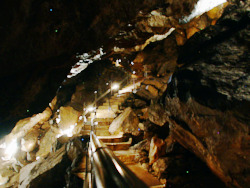
|
 Grottes de Lorette-Rochefort Grottes de Lorette-RochefortBelgium |
Die Grottes de Lorette in Rochefort in Belgien hat bei den meisten Leuten als einzige Besonderheit, dass sie in der Nähe der meistbesuchten Höhle Belgiens, der Höhle von Han, liegt. We don’t know if it’s because of the tourist magnet that there are so few visitors here, or would it be even less busy if Han’s cave wasn’t nearby? In fact, we think this cave is the most interesting cave in Belgium, while Han is more or less a Disney Land copy and totally overpriced. First of all, it has a very interesting cave museum to pass the time until the tour starts. And then it starts with climbing stairs, and that doesn’t stop until the end of the tour, it’s always going down or up. The whole cave consists of a very steeply inclined series of corridors and even the huge halls are constantly inclined, this is because they have all developed along an inclined fault zone. And because the halls are so large that it’s hard to imagine, there’s something very special here: the guide lets a hot air balloon called a "balloon" ascend during the tour. This has been impressively illustrating the dimensions to visitors for over a century. |
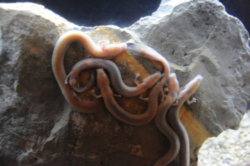
|
 Grotte de Choranche Grotte de ChorancheVercors, France |
The Grotte de Choranche has been open to the public since 1965. Back then, however, you still had to walk 45 minutes or ride a mule from the village of Choranche to get to the cave entrance. At that time, there was no electric light in the cave and tours were conducted using carbide lamps. But just two years later, the first electric light, powered by a generator, illuminated some parts of the cave. A new road provided easy access to the cave entrance. A highlight of the cave is the enormous amount of macaroni, thin, hollow stalactites that are normally only a few centimetres long. Here they have lengths of several metres. Another speciality are the cave olms (Proteus anguinus), which originally come from Slovenia. They were released for breeding in the cave of the C.N.R.S. (Moulis laboratory) and have probably settled in quite well by now. |
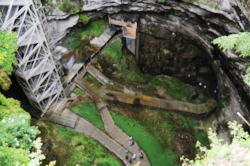
|
 Gouffre de Padirac Gouffre de PadiracLot, France |
The entrance to the Gouffre de Padirac is a spectacular shaft with a depth of 75 metres and a diameter of 33 metres.
This shaft opens naturally onto the surface of the Causses de Gramat and has therefore been known for a very long time, probably since the 13th century.
He gave the cave its name because gouffre means deep hole or bottomless pit in French.
The daylight shaft was already a famous tourist destination in the 19th century, when E. A. Martel (*1859-✝1938) visited the cave for the first time in 1889.
He undertook an initial expedition and discovered the cave at the bottom of the shaft and the cave river.
A year later, during a second expedition, he discovered today’s Salle du grand Dôme.
The exploration of the cave did not stop after Martel, and today more than 20 kilometres of cave flow have been discovered and surveyed.
A visit to this cave is very impressive due to its shaft, in which there is a steel tower. 455 steps or two lifts take visitors down into the cave and back up to the surface. From the bottom of the abyss at a depth of 75 metres, however, stone steps lead even further down to the cave river at a depth of over 100 metres. The journey now continues in boats and finally reaches the Salle du grand Dôme, which is 94 metres high. As the name suggests, the Salle des Grands Gours contains huge sinter basins, which are called gours in French. The most impressive speleothems are a 40 metre high stalagmite and a 25 metre long and 4 metre thick stalactite. |

|
 Abîme de Bramabiau Abîme de BramabiauCévennes, France |
The Bonheur (Happiness) river has its source near the Mont Aïgoual observatory on the border with the Cévennes. This area is not karstified, as it is not made of limestone, and the river flows on the surface. After 6 kilometres, it reaches the small karst area of Causse de Camprieu and immediately disappears underground. The river flows into a huge cave and forms an underground gorge. After 500 metres as the crow flies, it reappears and now the river’s name has changed to Bramabiau. The two entrances to the cave are huge and easy to see and have long been known to the locals. However, despite some prehistoric remains in a side arm, the cave was apparently never really explored as the wild and dangerous water prohibited this. At least until the end of the 19th century, when E. A. Martel began his cave explorations. He was on holiday in the area and was curious about this spectacular cave, so he persuaded a friend to explore this underground gorge with him. He had already visited several caves, but this was his first speleological tour. This day, 27 June 1888, is considered the birthday of modern cave exploration. |

|
 Aven d’Orgnac Aven d’OrgnacArdeche, France |
Aven d´Orgnac is characterised by big chambers, between 30 and 50 m high.
These enormous chambers are the reason why it contains the characteristic
 Palm Trunk Stalagmites.
Discovered and developed by famous caver Robert de Joly, the cave is only one of several show caves along the Ardeche River.
One of the unique specialties is an elevator which brings visitors from the deepest point of the tour back to the surface.
This makes the tours not only less strenuous, but also allows the visit to people who would otherwise be not fit enough, all in all its 120 m height difference. Palm Trunk Stalagmites.
Discovered and developed by famous caver Robert de Joly, the cave is only one of several show caves along the Ardeche River.
One of the unique specialties is an elevator which brings visitors from the deepest point of the tour back to the surface.
This makes the tours not only less strenuous, but also allows the visit to people who would otherwise be not fit enough, all in all its 120 m height difference.
|
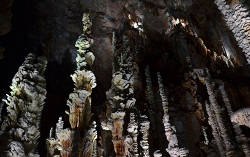
|
 Aven Armand Aven ArmandGrands Causses, France |
Aven Armand is located on a karst plateau called Causse Méjean or Les Causses at an altitude of 1,000 m asl. It was discovered by Louis Armand in 1897 as an unspectacular hole in the ground. He was a blacksmith from the nearby town Le Rozier and one day a few years earlier he had met Edouard Alfred Martel who was lawyer and spent his summer holidays in this area. In other words, apart from the fact that it is a grandiose hall with overwhelming plate stack stalagmites, made accessible by a funicular, it is also part of the history of cave exploration. |
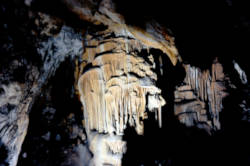
|
 Aggtelek Karst Aggtelek KarstUngarn  Jaskyna Domica Jaskyna DomicaSlovakia |
The Aggtelek Karst has four show caves, each of which is special in its own way. It is also possible to walk through the Baradla Cave from one show cave to another; this large-scale cave passage has even been developed with a path, but has no electric light. Another special feature is that the karst area crosses borders and one of the four show caves is located in Slovakia. During the Cold War, there was even an underground border fence to prevent GDR citizens from fleeing to the West via Slovakia and Hungary. |
 La Geoda de Pulpí La Geoda de PulpíSpain |
A Geode is a term used by mineral collectors to describe a bubble in the rock that is filled with minerals. Due to this cavity in the rock, water seeping through the pores of the rock transports minerals into the cavity and crystals begin to grow in the mineral-rich water. Generally, geodes with a diameter of a few centimetres are sold in mineral shops, pieces with a diameter of half a metre are very expensive. But sometimes a geode several metres in size is discovered, and in fact any natural hole in rock large enough for a human to enter is a cave, which is the definition of the term. We have listed eight geodes that are actually open to the public, and each of them is an exceptional and special sight. | |

|
 Grotta del Vento Grotta del VentoItalien |
Grotta del Vento (Wind Cave) is a cave system with several entrances at different heights. This creates a convection current whose direction depends on the season. Although the name "wind cave" is widespread, it is actually a misnomer - it should be called a blowhole. The developed part of the cave shows three completely different cave sections. The first has numerous beautiful speleothems, stalactites, shawls and cave pearls. The second is deeper, at the bottom of a 45 m deep pit and is sometimes filled with water. There are no limestone or calcite stalactites here, but rather rare clay stalagmites. The third part is located above the entrance siphon. The narrow path winds up a steep and craggy shaft and reveals an amazing vertical section of the cave. |

|
 Grotta Grande del Vento - Grotte di Frasassi Grotta Grande del Vento - Grotte di Frasassi |
Grotta Grande del Vento, the Great Cave of the Wind, is the most beautiful show cave in Europe.
Sometimes the beauty is explained by its late discovery in 1971.
There is no long history with centuries of visitors using burning torches and sooty candles.
But that’s only part of the story.
The cave is extremely large, the limestone is very pure, the sinter grows rapidly and forms extraordinary speleothems of all kinds.
The special geology with sulphurous springs in the lower level gives the cave an extra boost, with dissolution by sulphuric acid and the formation of gypsum-based minerals.
The stalagmites in the Abisso Ancona are typical
 Palm Trunk Stalagmites.
The water falling from the high ceiling has a high velocity, which leads to this different shape of the stalagmites, which look like palm trunks. Palm Trunk Stalagmites.
The water falling from the high ceiling has a high velocity, which leads to this different shape of the stalagmites, which look like palm trunks.
|

|
 Aven d’Orgnac Aven d’Orgnac |
This cave is characterised by large chambers that are between 30 and 50 metres high.
These huge chambers are the reason why it has the characteristic
 Palm Trunk Stalagmites
enthält.
This cave system has a natural entrance, a daylight shaft near the village of Orgnac, called le trou du Bertras (the hole of Bertras).
It is therefore easy to understand why the cave was later called Aven d’Orgnac (Abyss of Orgnac).
The tour descends a total of 120 metres through three halls, and at the end of the tour, visitors take the lift back to the surface. Palm Trunk Stalagmites
enthält.
This cave system has a natural entrance, a daylight shaft near the village of Orgnac, called le trou du Bertras (the hole of Bertras).
It is therefore easy to understand why the cave was later called Aven d’Orgnac (Abyss of Orgnac).
The tour descends a total of 120 metres through three halls, and at the end of the tour, visitors take the lift back to the surface.
|
| New Athos Cave Georgia |  Novy Afon Cave Novy Afon CaveGeorgien |
ახალი ათონის მღვიმე (New Athos Cave) is the most important tourist cave in Georgia. The actual name of the cave is Афон Ҿыцтәи аҳаҧы, the Abkhazian version of this name. Due to the deep entrance shaft, it was necessary to create an artificial entrance tunnel. As this tunnel is 1.3 kilometres long, a train was installed to take visitors through the tunnel into the cave and back. The single-track and electrified narrow-gauge railway (914 mm) has a third rail, similar to electric model railways. The third rail is used to supply the trains with 380 V direct current, only at points, and in passenger stations there is no third rail and the train runs on 240 V batteries. |

|
 Mammoth Cave National Park Mammoth Cave National ParkU.S.A. |
Mammoth Cave is the longest cave in the world with more than 570 kilometres of passages. This length is so extraordinary that the second largest cave in the world, Jewel Cave in South Dakota, USA, is not even half as long at 218 kilometres. And although it is very unlikely that the length of Mammoth Cave will be equalled by any other cave in the near future, the second place is constantly changing due to new discoveries. And it’s not just the length that is superlative, the lighting system was also renovated in 2006 at a cost of USD 6 million. The result was an electrical system with 1,200 light fittings, 73 kilometres of cables and 47 telephones for 9.6 kilometres of paths. It is a park in which several cave entrances (with different names) were each developed independently as show caves. In good years, the park offers well over 20 different tours. |
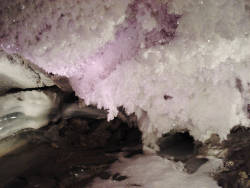
|
 Kungur ledenica pestera Kungur ledenica pesteraPerm, Russland |
With today’s political problems, Russia is not necessarily a great holiday destination. And the operators also realised years ago that hardly any international tourists were visiting them. The website is now only in Russian and the domain has been changed from com to ru. But this cave would really be a reason to take on some of the hardships. As the name suggests, this cave is known for its ice formations, and that in a large gypsum cave. Probably the strangest ice formations are snowflakes the size of a maple leaf. They change in size throughout the year and are at their most spectacular in late winter, making March the best time to visit the cave. This cave has a strange superlative as it is the lowest known ice cave at only 120 metres above sea level. Ice caves require a temperature of around 0 °C, which leads to the continuous formation and melting of ice. At lower temperatures, the cave would soon be completely filled with ice; at higher temperatures, there would be no ice. |

|
 Carlsbad Caverns Carlsbad CavernsNew Mexico U.S.A. |
Carlsbad Caverns is probably the most famous cave in the United States. There are longer caves, there are deeper caves, there are even more beautiful caves. But only very few! And no cave has as many top ten rankings as Carlsbad. The cave has a spectacular entrance portal, enormous halls, huge stalactites, rare cave minerals and thousands of bats. |
 Kartchner Caverns Kartchner Caverns |
Kartchner Caverns is a rather young show cave, and while there are certainly comparable show caves, none are as well preserved. It was only opened in 1999, and a great deal of emphasis was placed on protecting the cave during its development, a total of USD 20 million was invested in the development. As a result, this cave is probably the best preserved show cave in the world, the damage caused by the development was rigorously minimised and there is even an airlock to prevent any exchange with the outside air. The spectacular stalactites are certainly worth the effort. And the good state of preservation makes this extraordinary cave one of the most beautiful show caves in the world. |
 Search DuckDuckGo for "Show Caves Top 10"
Search DuckDuckGo for "Show Caves Top 10" The 10 Most Incredible Caves in the World (visited: 14-JUN-2025)
The 10 Most Incredible Caves in the World (visited: 14-JUN-2025)
 Index
Index Topics
Topics Hierarchical
Hierarchical Countries
Countries Maps
Maps